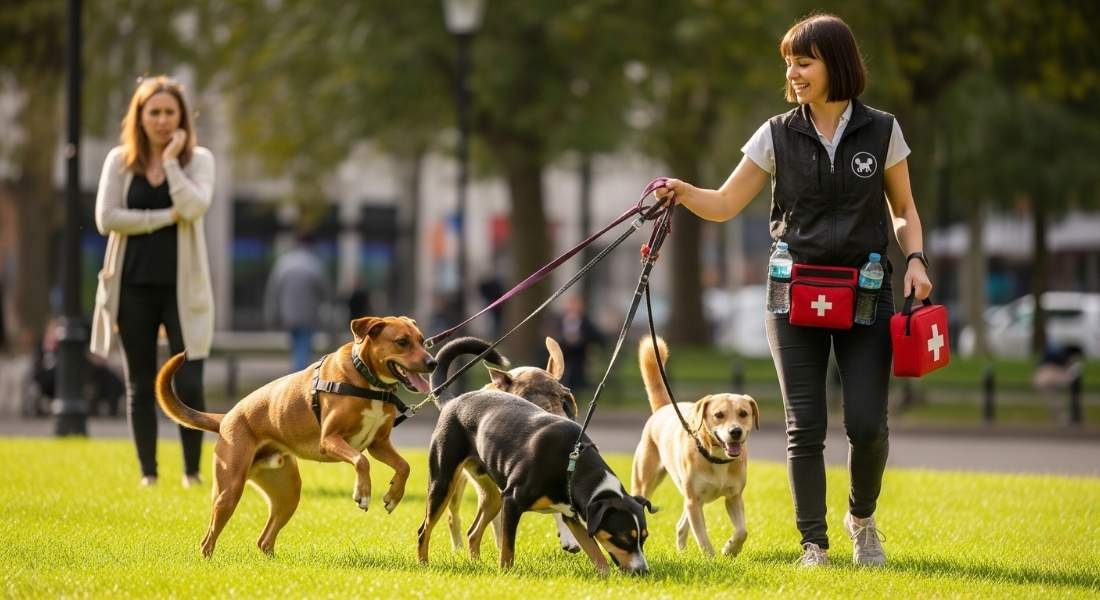Dog walking has evolved from a casual pastime into a professional service that demands a keen sense of responsibility and awareness of legal obligations.
As more individuals venture into the dog walking business, understanding public liability becomes paramount. This article delves into the critical aspects of public liability for dog walkers, unpacking the complexities and offering practical advice.
Understanding Public Liability Insurance
Public liability insurance is designed to protect businesses and self employed individuals against claims made by members of the public for incidents that occur in connection with their business activities. For dog walkers, this means coverage against potential injuries or damages caused while handling clients pets.
Public liability insurance is not just a safety net but it is a professional necessity that underscores your commitment to responsible business practices. It covers legal costs and compensation payments if you are found liable, safeguarding your financial stability.
Why Is Public Liability Important for Dog Walkers?
The importance of public liability insurance for dog walkers cannot be overstated. As a dog walker, you are entrusted with the care of clients beloved pets in public spaces where unpredictability reigns supreme. The following points highlight why this coverage is essential:
- Accidents Happen: Dogs can be unpredictable that can lead to accidents which may cause harm people or property.
- Legal Obligations: In many regions, having public liability insurance might be a legal requirement when offering professional services. So, do check it.
- Professionalism: Make sure to show professionalism and reassures clients that their pets are in safe hands.
- Financial Protection: You should make sure to shields your business from potentially crippling financial claims.
Key Risks Faced by Dog Walkers
Dog walking might seem straightforward, but it involves several risks that could lead to public liability claims:
Dog Bites or Attacks: A dog in your care might bite or attack another person or animal.
- Property Damage: Dogs might damage property while under your supervision, so stay alert.
- Slip and Fall Incidents: A passerby could trip over a leash or be knocked down by an enthusiastic pet, so make sure to keep check on dogs.
- Escaping Pets: A dog could escape and cause accidents or injuries, make sure to tie leash responsibly.
- Risks: You should understand these risks, they crucial for taking preventive measures and ensuring comprehensive coverage.
What Does Public Liability Insurance Cover?
Public liability insurance typically covers the following areas relevant to dog walkers:
- Third Party Injury: Compensation for injuries caused to individuals who are not part of your business.
- Third Party Property Damage: Costs associated with damage caused by the dogs under your care.
- Legal Fees: Covers legal expenses incurred while defending against claims.
While these are standard inclusions, policies can vary significantly between providers, which brings us to our next section.
Real World Examples and Case Studies
Examining real life scenarios can provide invaluable insights into the necessity of public liability insurance:
Example 1: The Overzealous Retriever
A professional dog walker was walking five dogs when one enthusiastic retriever knocked over an elderly man, resulting in a broken hip. The victim sued for medical expenses and pain and suffering.
Example 2: The Escape Artist
During an off leash exercise, one of the dogs escaped through a hole in the park fence, causing a multiple car accident on a nearby road. The incident resulted in claims from multiple drivers against the dog walker.
These cases illustrate the unpredictable nature of dog walking and emphasize the need for adequate protection through public liability insurance.
Choosing the Right Insurance Policy
Selecting an appropriate insurance policy requires careful consideration:
- Assess Your Needs: Determine the size of your operation and specific risks involved.
- Research Providers: Compare offerings from different insurers, focusing on coverage specifics rather than price alone.
- Read Reviews: Look for feedback from other professionals in the pet industry.
- Consult an Expert: An insurance broker specializing in pet business insurance can guide you in selecting the best coverage.
Remember, the cheapest policy may not provide comprehensive protection.
Industry Specific Insights: Best Practices for Dog Walkers
To minimize risks and enhance client trust, consider implementing these best practices:
- Training and Certification: Pursue professional training courses in animal handling and first aid.
- Leash Management Skills: Master effective leash handling techniques to prevent accidents.
- Emergency Preparedness: Carry basic first aid supplies and have an emergency plan in place.
- Clear Contracts: Use well defined contracts outlining responsibilities and liabilities with clients.
By adopting these practices, you demonstrate professionalism and reduce potential liabilities.
Legal Considerations for Dog Walkers
Operating within legal frameworks is crucial:
- Licensing Requirements: Ensure compliance with local regulations or licensing requirements specific to your area.
- Tax Obligations: Keep accurate financial records and comply with tax laws applicable to small businesses.
- Data Protection Laws: Safeguard client information as per data protection regulations.
Staying informed about legal requirements not only protects you from penalties but also contributes to your credibility as a professional dog walker.
Conclusion: Securing Your Future as a Dog Walker
Navigating the world of public liability insurance can seem daunting, but understanding its importance is non negotiable for any serious dog walker.
By assessing risks, choosing appropriate coverage, implementing safety practices and complying with legal standards, you secure not just your business but also peace of mind for yourself and your clients.
Embrace this aspect of professional responsibility as an investment in your future success as a trusted caregiver in the pet industry.









